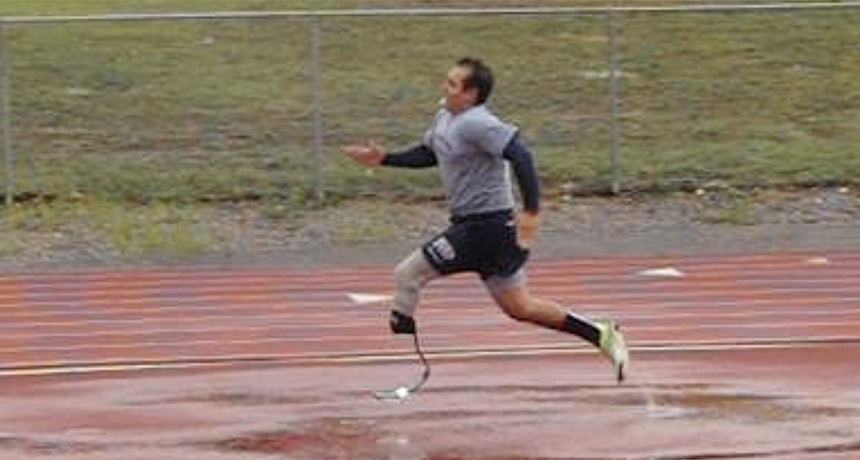Why Paralympic sprinters have trouble with curves
An artificial leg slows a runner when it’s on the inside of a curve

Paralympic runners lose more speed going around a turn when their affected leg is on the inside of the curve rather than the outside.
Paolo Taboga
Curves tend to put the brakes on human runners. They’re even harder for amputees using an artificial limb. Research now shows that even which leg the prosthesis is on can affect how fast someone can take a curve.
Two important forces are in play when a sprinter rounds a bend. First, working against gravity slows a runner. But centripetal (Sen-TRIP-eh-tul) force also is at work. It pulls something on a circular path toward the center of the curve. And it, too, will slow a runner down.
Studies have suggested that when an experienced sprinter goes around a turn, the inside leg creates less force than the outside one. So researchers at the University of Colorado at Boulder wanted to see how this might affect runners with artificial limbs. To find out, a team from its Applied Biomechanics Lab filmed such U.S. and German runners.
The Paralympic Games is an international sporting competition for athletes with physical disabilities. Like the Olympics, this group hosts summer and winter games every four years.
TAKING THE TURN Paralympic sprinters ran around a track clockwise and counterclockwise (shown in slow-motion). This helped researchers determine if how fast they cornered a curve had been affected by which leg — left or right — had been amputated. Paolo Taboga |
The scientists compared Paralympic sprinters who had amputations above the ankle to non-amputee runners. They also looked at each as they ran clockwise and counterclockwise around a track. Someone with a prosthetic limb on the inside of a curve ran 3.9 percent slower than runners with one on the outside of the curve.
Most amputee runners wear J-shaped prosthetic limbs. That absorbs then releases energy, much as a human ankle does. But these devices can’t create as much force as a real ankle does. So amputee runners make up for this by swinging their legs faster.
Sprinters whose prostheses were on the inside of a curve also decreased the speed of their steps, the researchers found. So they couldn’t compensate as well for their artificial limb generating less force against the ground compared to a regular ankle.
Paralympic races always run counterclockwise. Left-leg amputees therefore may be at a disadvantage, the data indicate.
The team published its results in the March 16 issue of the Journal of Experimental Biology.
Power Words
(for more about Power Words, click here)
amputation The removal of part or all of a limb (such as a finger, hand or arm) from the body. This can be done using surgery, when it’s necessary to treat a disease or infection, or it can occur as a result of an accident or trauma. Someone who has lost an arm or leg is called an amputee.
centripetal force A force that acts on an object as it moves along a curved path. This force is directed into the center of the curve or circle. (Centripetal means “center seeking” in Latin.)
force Some outside influence that can change the motion of a body, hold bodies close to one another, or produce motion or stress in a stationary body.
gravity The force that attracts anything with mass, or bulk, toward any other thing with mass. The more mass that something has, the greater its gravity.
phenomenon Something that is surprising or unusual.
prosthesis An artificial device that replaces a missing body part. Such a prosthetic limb, for example, would replace parts of an arm or leg. These replacement parts usually substitute for tissues missing due to injury, disease or birth defects.
prosthetic Adjective that refers to a prosthesis.
sprint To run at top speed over a fairly short distance. In competitive running, the 100-meter race is a sprint. A person who is doing this kind of running is called a sprinter.







